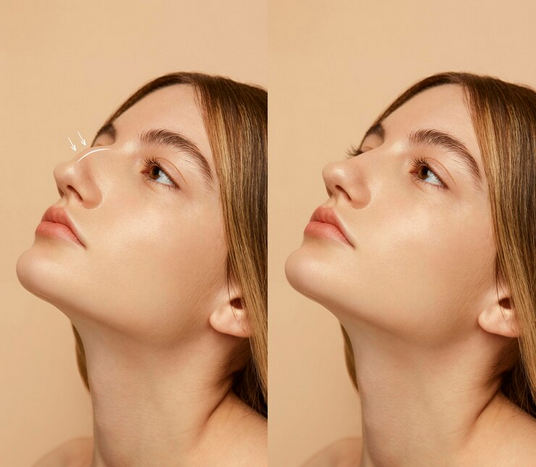Introduction
In the realm of non-surgical cosmetic enhancements, the use of nose fillers has gained significant popularity for those seeking a more refined and harmonious facial profile. This guide delves into the nuances of nose fillers for wide nose, exploring the procedure's benefits, considerations, and the transformative impact it can have on one's appearance.
Understanding Nose Fillers
Nose fillers, also known as non-surgical rhinoplasty or liquid rhinoplasty, involve the use of dermal fillers to reshape and enhance the appearance of the nose. The procedure is a minimally invasive alternative to traditional surgical rhinoplasty, offering individuals the opportunity to address specific concerns without the need for incisions or downtime.
Benefits of Nose Fillers
Non-Invasive Nature:
One of the key advantages of nose fillers is their non-invasive nature. Unlike surgical rhinoplasty, which requires anesthesia and incisions, nose fillers involve strategically placed injections. This minimizes the risks associated with surgery and reduces recovery time.
Quick Results:
Nose fillers provide immediate results. Patients can witness the transformation in their nasal profile almost instantly after the procedure, making it an appealing option for those seeking a rapid enhancement without the prolonged recovery period associated with surgery.
Reversibility:
The temporary nature of the fillers, often composed of hyaluronic acid, allows for reversibility. If a patient is dissatisfied with the results or experiences any complications, the filler can be dissolved, restoring the nose to its original state. This reversibility adds an extra layer of safety and flexibility to the procedure.
Considerations Before Opting for Nose Fillers
While nose fillers offer a range of benefits, it's essential to consider certain factors before deciding to undergo the procedure.
Realistic Expectations:
Understanding the limitations of nose fillers is crucial. While they can address certain aesthetic concerns, they may not be suitable for all nasal issues. It's important to have realistic expectations and consult with a qualified practitioner who can assess whether nose fillers align with the desired goals.
Provider Selection:
The expertise of the practitioner performing the nose filler procedure is paramount. Researching and selecting a qualified and experienced professional is essential for achieving safe and satisfactory results. Look for practitioners with a background in facial aesthetics and a proven track record in non-surgical rhinoplasty.
Potential Risks and Side Effects:
Like any cosmetic procedure, nose fillers carry potential risks and side effects. These may include temporary swelling, bruising, or redness at the injection site. Consulting with the practitioner beforehand and following post-procedure care instructions can minimize these risks.
The Nose Filler Procedure
Understanding the step-by-step process of nose fillers can help individuals prepare for the procedure and set realistic expectations.
Initial Consultation:
The journey typically begins with an initial consultation. During this session, the practitioner assesses the patient's nasal anatomy, discusses the desired changes, and explains the potential outcomes of the procedure. This consultation is also an opportunity for the patient to ask questions and address any concerns.
Customized Treatment Plan:
Based on the assessment, the practitioner creates a customized treatment plan. This plan outlines the areas of the nose that will be addressed, the amount of filler required, and the expected results. Tailoring the procedure to the individual's unique facial features is key to achieving a natural-looking outcome.
The Procedure Itself:
The actual nose filler procedure is relatively quick, typically taking around 15 to 30 minutes. The practitioner strategically injects the filler into specific areas of the nose to achieve the desired contour and symmetry. While discomfort is minimal, some practitioners may use topical anesthetics to enhance the patient's comfort.
Post-Procedure Care and Recovery
After the nose filler procedure, following recommended aftercare guidelines is essential for optimal results.
Avoiding Pressure and Touching:
Patients are advised to avoid applying pressure or touching the treated area immediately after the procedure to prevent the filler from shifting.
Managing Swelling:
Some degree of swelling and bruising is normal. Applying ice packs can help minimize these effects. However, patients should consult with their practitioner before using any cooling treatments.
Limiting Physical Activity:
Strenuous exercise and activities that may increase blood flow to the face should be avoided for the first 24-48 hours after the procedure.
Conclusion
Nose fillers have emerged as a powerful tool for individuals seeking to refine their facial profile without the commitment and downtime associated with surgical rhinoplasty. By understanding the benefits, considerations, and procedural aspects of nose fillers, individuals can make informed decisions to achieve a more harmonious and aesthetically pleasing nasal appearance. It's essential to approach the procedure with realistic expectations, select a qualified practitioner, and prioritize post-procedure care for a safe and satisfying transformation. As the popularity of non-surgical rhinoplasty continues to rise, the power of nose fillers in creating subtle yet impactful changes is indeed reshaping the landscape of cosmetic enhancements.





Comments